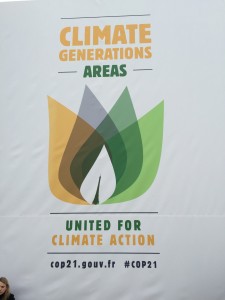By Dr. Adam Fenech
 I’ll be there in Paris next week for the conference where the United Nations will negotiate a legally binding agreement on climate with the aim of keeping global warming below a dangerous level of 2°C. Discussions have turned to carbon pricing as a means of reducing greenhouse gases to combat global warming such as cap-and-trade systems. The “cap” is like a license to pollute up to a certain threshold, setting a limit on greenhouse gas emissions, which is lowered over time to reduce the amount of pollutants released into the atmosphere. The “trade” creates a market that allows large industries to trade their polluting licences amongst each other. Each industry is given a license to emit a certain amount of greenhouse gas, known as a carbon allowance, and they can do so, or innovate in order to meet or come in under their allocated limit. The less they emit, the less they pay, so it is in their best interest to pollute less and save money, as they can sell the remainder of their allowance.
I’ll be there in Paris next week for the conference where the United Nations will negotiate a legally binding agreement on climate with the aim of keeping global warming below a dangerous level of 2°C. Discussions have turned to carbon pricing as a means of reducing greenhouse gases to combat global warming such as cap-and-trade systems. The “cap” is like a license to pollute up to a certain threshold, setting a limit on greenhouse gas emissions, which is lowered over time to reduce the amount of pollutants released into the atmosphere. The “trade” creates a market that allows large industries to trade their polluting licences amongst each other. Each industry is given a license to emit a certain amount of greenhouse gas, known as a carbon allowance, and they can do so, or innovate in order to meet or come in under their allocated limit. The less they emit, the less they pay, so it is in their best interest to pollute less and save money, as they can sell the remainder of their allowance.
The cap-and-trade system worked very well to combat the acid rain issue back in the 1980s. Acid rain is rainfall that is made so acidic by atmospheric pollution that it causes environmental harm, typically to forests and lakes. The main cause is the industrial burning of coal and other fossil fuels, the waste gases from which contain sulfur and nitrogen oxides, which combine with atmospheric water to form acids. Much of eastern Canada is affected by acid rain caused in central Canada and the United States. An agreement between Canada and the USA in 1990 reduced acid rain-causing sulphur dioxide emissions by almost 40 percent. To help industry meet these reductions, the US government created a cap-and-trade system for sulphur dioxide (SO2) emissions from the nation’s 3,200 coal plants. The system created a market for firms to buy and sell government-issued allowances to emit SO2. By 2007, annual emissions had declined below the programme’s goal for a total of 43% reduction from 1990 levels, despite electricity generation from coal-fired power plants increasing more than 26% from 1990-2007.
In economic theory, a cap-and-trade scheme can be cost effective, meaning the total costs of pollution reduction are minimised. Because each company has flexibility to choose the course of action, it costs the least to achieve environmental compliance – broadly either reduce its own emissions or buy more allowances to cover its emissions. Investment flows to where it is least costly to reduce emissions. The cost of pollution reduction becomes equalised across all regulated companies, and, in total, the mandated environmental target is achieved at lowest cost.
The province of Quebec entered a carbon cap-and-trade system in 2013 whereby businesses that emit 25,000 tonnes or more of greenhouse gases (carbon dioxide equivalent or CO2e) a year are subject to the cap-and-trade system. Presently, only the industrial and electricity sectors are subject to the system, but soon it will include fossil fuel distributors. In 2014, Québec linked its system with that of California, thus creating the largest carbon market in North America, and the first one in the world to have been designed and to be operated by subnational governments of different countries. The Western Climate Initiative’s (WCI) carbon market has expanded further to include the provinces of British Columbia and Manitoba, with the expected addition of Ontario soon. Prices per tonne of carbon allowance are about $16.
There is another cap-and-trade system operating close to Atlantic Canada known as the Regional Greenhouse Gas Initiative or RGGI that includes eight northeastern United States (Maine, Vermont, New Hampshire, Massachusetts, Connecticut, New York, Delaware and Maryland) who have capped their greenhouse gas emissions at 88.7 million tonnes declining 2.5% each year until 2020. The cap is already down to 66.8 million tonnes in 2015. The carbon allowances are sold at auction raising $2 billion that is now invested in energy efficiency, clean and renewable energy, direct consumer bill reductions and other greenhouse gas reduction programs. The auction prices for carbon allowances under RGGI have ranged from $2 to $6 per tonne.
Critics have cited problems with monitoring the reductions in emissions but I think this could be accomplished if 3,200 coal plants in the USA have participated in a successful acid rain reduction program. Others have a problem with giving industry a license to pollute no matter if the overall goal is a reduction in this pollution. But we have to accept that our present lifestyle requires that wastes be produced. And until we move completely to renewal energy such as using solar or wind power, we’ll have to accept some greenhouse gas emissions. Perhaps forever.

